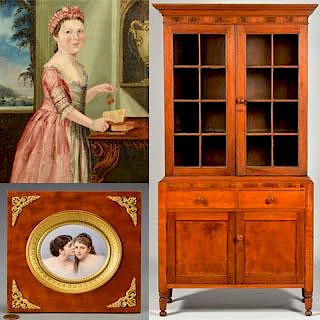Rutherford B. Hayes Official White House China Plate
About Seller
4310 Papermill Dr. NW
Knoxville, TN 37909
United States
Case Auctions is based in Knoxville, Tennessee, where our gallery is located, with satellite offices in Nashville, Tennessee and Kingsport, TN – but our reach is worldwide. Established in 2005, we conduct cataloged auctions of investment-quality art and antiques under the stewardship of knowledgeabl...Read more
Two ways to bid:
- Leave a max absentee bid and the platform will bid on your behalf up to your maximum bid during the live auction.
- Bid live during the auction and your bids will be submitted real-time to the auctioneer.
Bid Increments
| Price | Bid Increment |
|---|---|
| $0 | $10 |
| $100 | $25 |
| $500 | $50 |
| $1,000 | $100 |
| $3,000 | $200 |
| $5,000 | $500 |
| $10,000 | $1,000 |
| $20,000 | $2,000 |
| $50,000 | $5,000 |
| $100,000 | $10,000 |
About Auction
Jan 23, 2016 - Jan 24, 2016
Case Auctions bid@caseantiques.com
- Lot Description
A White House Haviland Limoges porcelain fish plate from the Rutherford B. Hayes service, designed by artist Theodore R. Davis, depicting two lobsters, signed lower right D on front. The back contains the full artist signature with TD cypher, presidential eagle, and Haviland Limoges mark. (Mark illustrated in the book Official White House China, 1789-the Present by Margaret Brown Klapthor, p. 107), 8 3/8" diameter. Provenance: the estate of Anne Sexton Shockley of Nashville, by descent from her great-grandfather John Houston of Nashville, a former employee and personal friend of David Haviland. Houston moved to Nashville in the mid-19th century and partnered with A.H. Hicks in his porcelain importing business located at 46 Public Square. Note: The Hayes Service is considered one of the most important, imaginative, and extravagant porcelain services ever produced. Negotiations a the new state dinner service for the White House began in 1879, as it was customary to order new porcelain when a new president took office. Haviland was awarded the contract over Minton and Wedgwood. During a chance meeting with Mrs. Hayes in the White House conservatory, Theodore R. Davis, an artist for Harper's Weekly, suggested the service be designed with exclusively American flora and fauna, with each piece having a different decoration. Mrs. Hayes liked the idea so much that she asked that Davis assume direction of the designs. From his drawings, etchings were produced for transfer of the outlines to many new dish shapes; basic coloring was applied by chromolithographic and decalcomania processes and then shaded by decorators. It debuted to mixed reviews from art and design critics, but the service was wildly popular with the public. As a result, some of the Hayes designs and forms were patented and reproduced for public sale as well, but on these the pennant mark dated 1879, unique to the White House service, was replaced by a blue 1880 patent mark. (Source: whitehousehistory.org, Official White House China 1789-the Present by Margaret Brown Klapthor). Klapthor quotes Davis that many pieces admired by Hayes' successor, President Chester Arthur, were removed from the White House during the summer months and taken to decorate the dining room of his vacation home. She also notes that "it is possible that the sample china which came into this country to the stores in Washington, New York and Boston during the summer of 1880 had the same mark as the set delivered to the White House, for the patent onthe designs was not secured until August." See two related plates in this auction from the same estate. (Higher-resolution photos are available at www.caseantiques.com)Two 1/4" shallow flakes to decorated portion of rim and a 1/4" chip to lower white rim, some scattered minute flakes/enamel loss to painted image.
Condition
- Shipping Info
-
Buyer Pays Shipping Cost – Buyers are responsible for making shipping arrangements through our recommended shippers or a shipper of their choice. For shipping estimates, contact these shippers with the lot number(s) or a shipper of your choice. Our recommended shippers follow:
Package Manager of Knoxville, 865-584-3000, info@packagemanager.net (The Manager is Gwynn).
The UPS Store of Lenior City, 865-988-5526, auction4526@theupsstore.com (The Manager is John).
The UPS Store of Northshore Knoxville, 865-951-2499, store6461@theupsstore.com (The Manager is Jonathan).
The UPS Store of Downtown Knoxville, 865-584-0081, store2630@theupsstore.com (The Manager is Nathan).
-
- Buyer's Premium



 EUR
EUR CAD
CAD AUD
AUD GBP
GBP MXN
MXN HKD
HKD CNY
CNY MYR
MYR SEK
SEK SGD
SGD CHF
CHF THB
THB



















